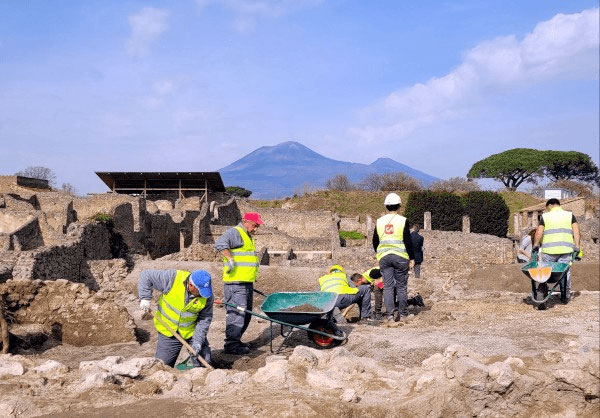 NAPLES, ITALY—According to a statement released by the Archaeological Park of Pompeii, almost an entire block in the central area of the ancient city is under excavation by a team of researchers made up of archaeologists, archaeobotanists, volcanologists, topographers, architects, engineers, and geologists. So far, they have uncovered the masonry ridges of the upper floors of the buildings in Insula 10 of Regio IX, which is located along Via di Nola. One house, previously excavated in 1912, had been converted into a laundry. An oven and an upper floor were uncovered in another structure. Evidence of farming and traces of outbuildings dated to the eighteenth century have also been found. The work is part of the Great Pompeii Project, whose aim is to improve the conservation of the site by strengthening the borders between the excavated areas of the city and those still covered with lapilli and ash from the eruption of Mt. Vesuvius in A.D. 79. The heavy layer of ash in unexcavated areas of the city can put pressure on adjacent excavated walls, which can also be exposed to damage from rainwater, explained Gabriel Zuchtriegel, director of Pompeii Archaeological Park. To read about other recent archaeological research in the ancient city, go to "Digging Deeper into Pompeii's Past."
NAPLES, ITALY—According to a statement released by the Archaeological Park of Pompeii, almost an entire block in the central area of the ancient city is under excavation by a team of researchers made up of archaeologists, archaeobotanists, volcanologists, topographers, architects, engineers, and geologists. So far, they have uncovered the masonry ridges of the upper floors of the buildings in Insula 10 of Regio IX, which is located along Via di Nola. One house, previously excavated in 1912, had been converted into a laundry. An oven and an upper floor were uncovered in another structure. Evidence of farming and traces of outbuildings dated to the eighteenth century have also been found. The work is part of the Great Pompeii Project, whose aim is to improve the conservation of the site by strengthening the borders between the excavated areas of the city and those still covered with lapilli and ash from the eruption of Mt. Vesuvius in A.D. 79. The heavy layer of ash in unexcavated areas of the city can put pressure on adjacent excavated walls, which can also be exposed to damage from rainwater, explained Gabriel Zuchtriegel, director of Pompeii Archaeological Park. To read about other recent archaeological research in the ancient city, go to "Digging Deeper into Pompeii's Past."
New Excavation at Pompeii Underway
